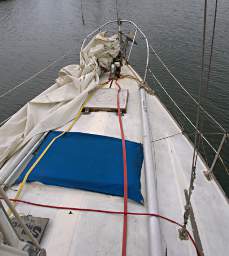
The Place You Crawl to Get to the Anchor
when the Boat is being Buffeted in a Storm
I left Placencia some time before noon, heading south. I was approaching the turn to New Haven at about 15:30. There is a small cay north of there, and since the weather was nice I decided to anchor behind it instead of going around the corner into New Haven. There are a couple of shoals to avoid going in to New Haven, and as I wanted to get an early start the next morning for the hop to Livingston, I figured that by anchoring behind the cay I would save myself some time. It's a straight, unobstructed shot to Livingston from there. High tide was around 15:00 and so I would have to arrive in Livingston relatively early to make it across the bar with the tide.
Visibility was poor, considering the nice weather -- maybe 5 mi at best. It was hazy as heck. I was anchored relatively close to the cay in about 20 feet of water. There were shoals below me off the south end of the cay, and it was somewhat exposed to the northeast. I had all 125 feet of chain out, plus a bit of line. I was in so close I was worried about sand fleas being an issue, since the mosquito netting I have is not small enough to keep them out.
The Belizian coast is about as flat and uninteresting as one can get. It's uninspiring, and couple that with orange grove development and second / vacation home lagoon development and you have a real mess. But at the moment it was pleasant, a nice evening with just the right amount of breeze.
At about dusk I was getting something off the navigation table and happened to look at the barometer. Yowzer! It had plummeted, dropping about 0.1" in an hour or so. I don't normally keep all that close track of it, but this chance encounter caught my attention. I remember thinking, "That's supposed to mean something. Like some major weather in the next 12 hours or so." When I went back topside I took a good look around. The cay obscured the low horizon to the east. The whole eastern sky was gray, but that didn't seem much out of the ordinary. There are always afternoon and evening squalls, and they often darken much of the horizon. I didn't see any big thunderheads, and no lightning. I thought briefly about weighing anchor and scooting around the corner to New Haven, but it was almost dark and that would be a bit difficult. I surveyed my position behind the cay a little more carefully, and decided I should be ok as long as I didn't drag. But the drop in the barometer kept nagging at the back of my mind.
At 22:00 in the pitch dark, it hit. Wow. Howling winds, screaming in the rigging. I have no idea what speed, but higher than anything else I've been in, and that's about 45 knots. There was almost constant lightning, all around, although fortunately almost all cloud to cloud and not bolts to ground. There was so much lightning that I didn't need a flashlight to check if I was staying put or not, or to look at the shoals to the north and south off the ends of the cay. Despite the fact that there was virtually no fetch between me and the cay, there were one to two foot high waves on both sides of me. Malakii was riding ok, and didn't seem to be pulling on her anchor too hard, but I was pretty nervous. I put up the riding sail as she was hunting badly, probably 90 degrees. I could see much larger waves about 50 meters off to port, waves that hadn't been obstructed by the shoal on the north end of the cay. Then the rain hit, and it seemed like a lot but maybe no more than 1" total. I put on my harness, clipped in, and crawled to the bow, where I let out the CQR on a short leash of chain to try to lessen the hunting. Then there was not much to do but watch the cay in the lightning and try to ascertain that we weren't dragging. I certainly wasn't going to go below and try to sleep. I kept reminding myself, "It's the water, not the wind, you need to worry about." And the cay was keeping the water pretty well in control, at least close by, which was what mattered.
 |
| Foredeck --
The Place You Crawl to Get to the Anchor when the Boat is being Buffeted in a Storm |
By 23:30 the worst had passed. It was still blowing and booming but not as badly, and I calmed down my worries and went to bed.
By morning everything was calm as could be, as if nothing had happened. The wind had swung around to the west, and we were up really tight to the cay.
I used the engine to get out, as the wind was pushing us into the cay and we didn't have squat for maneuvering room. Then I raised the sails, cut the engine, and pointed Malakii towards Livingston. Once under way, I fixed myself some breakfast and noted the landmarks slipping behind us.
But then, criminy! The wind died about 10:30. I couldn't decide whether to take it easy and wait for the wind to come back up, which it always does in the afternoon, and head for Cabo Tres Puntas for the night; or start the engine and try to make Livingston. They were about the same distance, but I had to cross the bar of Rio Dulce to get into Livingston, and I wanted a high tide for that; high tide was about 15:00. I finally decided on Livingston and started the engine.
I found a spot up on deck hiding in the shade of the mainsail and let "Auto" do the driving. About an hour later the wind picked up a little, so I went back to the cockpit to trim the sails and raise the jib. Yikes! There was smoke / steam coming out of the cabin, and the engine temperature was too high. I shut the engine down as fast as I could, then finished trimming the sails. There was enough wind for us to inch along, so we did.
One of the many things on my to-do list for Malakii is to hook a buzzer up to the temperature gauge and the oil pressure sensor for the engine. But it's quite a ways down the list, one of those round toits I haven't gotten to yet.
I figured the raw water pump impeller had croaked, as I have had that happen on a few occasions. If that was the case I wasn't going to mess with it until we were on the hook someplace and I didn't have anything else to worry about.
I could have let "Auto" do the steering, but under the tight time constraints I decided to hand steer, as I can trim the sails better that way. "Auto" does a pretty good job, but you can't sail right on the edge pointing into the wind using him; he always overshoots a bit, so you have to trim back enough so when he overshoots you don't end up luffing and tacking or ending up in irons.
So here I was, sailing along peacefully minding my own business, working my way towards Livingston. I was about half way, twelve or so miles from the Belize coast and about the same from Guatemala. And then, bzzzzzzzz, a stinking bee shows up. It wasn't real speedy, and I didn't want it setting up house in the boat, so I grabbed a tee shirt I had hanging on the lifelines and squashed it. Then there was another, and another, and another, and I squashed them all. I came close to panicking, fearing I would be swarmed by a hive of bees. I thought maybe they had somehow miraculously survived the pesticide in the mast and were newly hatched, but more likely they were out on a search mission from the mainland. In any case, they kept coming, by twos, by threes, by fours. Just slowly enough that I could more or less keep up with them, squashing them as they arrived. I felt a bit badly, as I don't have anything against bees; I actually like them, beneficial insects that they are, some of the great pollinators of the world. But they can't have my boat. So I kept on squashing them. Eventually, they either gave up or I squashed them all. My tee shirt was a mess, covered with squashed bees. But I was relieved when they stopped showing up.
 |
| Bee Stained Tee Shirt |
The wind slowly picked up, and by 13:00 I had to decide whether to continue to Livngston or spend the night off Cabo Tres Puntas. I decided to go for it, counting on the wind picking up as the afternoon wore on. At 15:00 we were at the sea buoy. We sailed across the bar and on in ok, but saw 5.4 and 5.2 on the depth sounder, although Malakii never touched bottom. I had barely gotten the hook down when Raul called me on the radio and urged me to check in ASAP; he closed at 16:00 and the next day was a Saturday and he wasn't working and would have to charge me extra to check in then.
I scurried around to get things tidied up enough to go ashore, then lowered the dinghy, put the motor on, and went ashore. After checking in I returned to the boat to check out the engine. When I started inspecting the engine I saw right away what the problem was -- the fresh water pump / alternator belt was shredded. Whoppie! That was a heck of a lot better than a trashed raw water pump impeller. I pulled out the spare, only to discover that it didn't fit. It was too fat, like most Americans; and too short. So I pulled out the second spare, and it was just like the first one. Damn. I wrestled with the spares, and wrestled with the alternator, and wrestled with the spares some more. I tweaked the alternator mounting bracket, then wrestled some more, but I could not get the belt on.
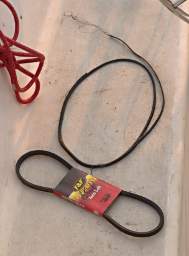 |
| Shredded Fan Belt |
While I was fighting the alternator / water pump belt and trying to stretch it on to the alternator pulley, the fitting at the bottom of the galley sink fell off. The galley sink is located directly above the engine compartment, so the drain hose runs down through it. When the fitting on the bottom of the sink came off, I grumbled and looked at it and grumbled some more. It was a cheap household plumbing fitting, not a sturdy corrosion-resistant marine version. I grumbled some more and noted it as something I needed to fix, then casually pushed the hose to the side out of the way so I could get back to the task at hand. As I pushed the hose out of the way it flopped over, and water started gushing out the end.
Yikes! That got my attention, as I registered that the other end of that hose was connected to a thru-hull -- a hole in the bottom of the boat! Ooooooooops! I scrambled and shut off the seacock at the thru-hull, then went back to wrestling with the belt. About five minutes later the hose from the fresh water pump to the heat exchanger fell off. A true Captain Ron moment...
There was one more belt; I don't know where it came from, as it was on the boat (along with one of the spares that didn't fit) when I bought her. Wisely, for once, I had not thrown it away. It was worn a fair amount, and clearly meant for some other application, as the ribs were on the opposite side from the vee and it was a bit skinny / wimpy. But it fit, and when I started the engine up everything worked fine. Whew!
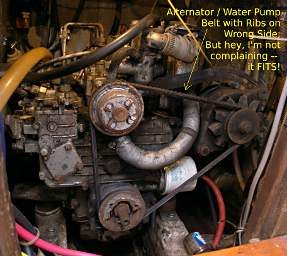 |
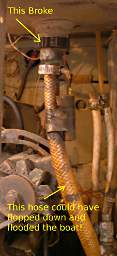 |
| Reversed Fan Belt | Galley Sink Drain |
Now all I had to do was fix the water pump to heat exchanger hose that had fallen off. The hose didn't leak, it had just come loose. It didn't fit on the fresh water pump very well, so I decided to fix it while I was at it. I went through all my spare hoses and discovered something I had forgotten -- the fresh water pump output is nominally 1", as is the heat exchanger input. Unfortunately, the manufacturers' ideas of "nominal" were not the same, so one is a true 1" I.D. and the other is 15/16". So no hose will really fit both properly.
I decided to sleep on it and see if I could find a hose in Livingston in the morning. It looked like another rain storm was on the way. I hoped it was just the usual afternoon spit and not another monster like the previous night. I was anchored a little further out than usual, not tucked back in by the fishing boats the way I usually do. I watched as the rain came in, spit a few times, and headed off to someplace else. Then I settled down to sleep, one tired guy.
I woke at 22:30 after a bad dream. I was back at Union, my undergraduate college. Everything in Schenectady is built up, so you can't orient by going outside and looking for the Nott Memorial. My friends Kent and Vic? Mike? Steve? are leading me somewhere, but don't keep track of me -- like a bad lead car when you're following someone. There are all sorts of weird carnival ride like places with weird entry / exits around us. Slides, doors like those pneumatic money canisters at a drive up window. There's no place to "be outside" and yell "Kent". One of the slides has wire fingers, kind of like those deer escape gates on highway fences so if they end up on the highway side they can go out but not back in. As I go out one of them, one of the wire fingers flips off my glasses. Ayyyyyyy! Whew! Glad I woke up... The noise from Friday night in Livingston was still booming away on shore, but I managed to clear my head and go back to sleep anyway.
I woke up at 08:00 and after thinking about it, decided that there was no point in trying to find parts in Livingston. There are no roads going in and out of Livingston, so there are few cars. Auto parts like belts and hoses would be difficult to find; there's only one hose shop up in Fronteras, and there are a lot of vehicles up there. And on a Saturday, only the tourist shops would be open. I ended up putting the old hose back on the fresh water pump and made sure the hose clamps were on properly; or at least as properly as I could get them.
Everything looked good, so I cranked up the engine. Voila! She runs! The alternator / fresh water pump belt was spinning nicely. I went to the back of the boat to check to make sure the raw water was circulating, and there wasn't much coming out. Damn. I immediately suspected the impeller, and shut the engine off.
I noticed there was a lot of water in the bilge, and I had emptied it the night before after the fiasco with the sink drain hose. That didn't seem right, and I emptied it again. Then I started the engine up to see where the water was coming from. I could hear a hissing noise... yikes! I couldn't see where exactly, but it looked like water was gushing out the side on the engine. I feared the worst, like a plug blown out in the block like the ones for installing block heaters. But after a few checks I discovered yet another hose coming off, this time the one on the output side of the raw water pump. I took it off and it looked fine, but it obviously wasn't seated correctly. I tried putting it back on properly, and couldn't. Damn.
Oh, for parts that are compatible. Like the fresh water side, to two end points where the hose connected were different sizes. The raw water pump requires a full 1" diameter (I.D.) hose, and the heat exchanger where the other end goes is only 15/16". Without much enthusiasm, knowing ahead of time the result, I again tried every hose in my spares; as expected, none would fit. I tried using boiling water to soften them and pounding a thru-hull plug into them, but got nowhere. Finally, I looked at the stoutest hose and decided it had a really thick inner wall. Sometimes you just have to make things work. I took out my super-sharp, saved and only used when needed Boye knife and shaved about 1/32" off the inside of the hose all around. It wasn't pretty, it wasn't smooth, it wasn't up to ABYC specs, but you know what? It went on, and the hose clamp snugged it up fine. Well, the second hose clamp. Of course the first (old) one went "click-click-click" and skipped its threads. The other end seated nicely as is. I fired up the engine and everything looked good.
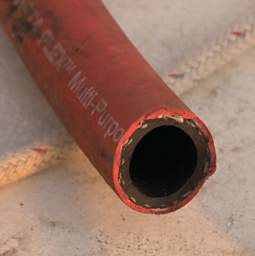 |
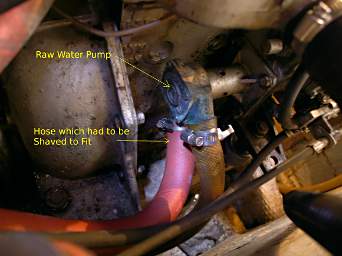 |
| Undersized Hose ...
but thick enough to shave on the inside. |
Raw Water Pump Hose |
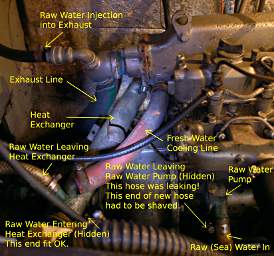 |
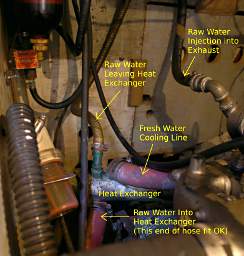 |
| Heat Exchanger | Raw Water Pump Hose |
I decided to eat breakfast before heading up the river, as I would be tacking all the way on short tacks and wouldn't be able to eat and sail at the same time. While eating I took a good look at the river, and it looked like we were making at least two knots just sitting there. I checked the tides and it was pretty much low tide. I decided to wait a bit and got out my banjo. The tide wouldn't matter much after the first mile or so, as it was only 1.3 feet; but it would make getting started easier.
I tidied up, brought up the anchor, and started up river, trying to sail. But the current was so strong I couldn't make any headway. So I turned the engine on and began motor sailing. Familiarity often makes one less careful than one should be, and I was feeling too familiar with the Livingston harbour. I'd sailed in and out of it quite a few times and never really worried much about the depth when heading back upstream. So I wasn't paying as much attention as I should have. The river runs a lot of water and is deep as it comes out of the canyon into the harbour. For most of its length, you can sail right up to the shoreline. When coming down the river, I always head over towards the fishing fleet near the town dock and never come near the south shore once I'm into the bay very far. When heading out to sea, I never stray much past the middle of the bay where the course to the sea buoy is. And when heading up river, there is usually enough wind and not too much current and I can pretty much sail straight to the mouth of the river. But this time there was a lot of current and not much wind, and I needed to tack back and forth to make it to the mouth of the river. I was trying to get as much distance on each tack as possible. I was still a fair ways from the south bank when I realized it was getting shallow, and promptly got stuck in the mud.
Ugh, again. The bottom was soft mud, a good thing. I ran out the spinnaker halyard with the stern anchor as a kedge. Then I ran out a bow anchor, put it on the windlass, and winched the bow around. That gained us a little ground, but we weren't free. I figured if I waited long enough, the tide would probably float us. The kedge didn't grab, so I ran it out again. I put a buoy on it so I could turn it loose in case help arrived to pull the boat over using a launch. Three locals came up and offered to help but didn't have a big motor. Meanwhile the tide had raised us enough the windlass could pull us off. Once free, I took in the spinnaker halyard so I could grab the line to the kedge. The kedge wasn't grabbing, so I was pulling it as far in as I could with the halyard, figuring the steep angle to the top of the mast would keep it from setting and make retrieving it easier. I left the buoy attached so I could see when the end of the halyard where the knot to the anchor line was was getting to the top of the mast. The fender I was using as a buoy had a short line at each end; I didn't think much about it until it wrapped on the halyard coming down the mast, at which point I realized it was stuck up in the spreaders. I couldn't lower it because the line caught on the halyard going up the mast would jam at the block at the masthead. Fortunately I had the main halyard still, so I pulled the mast steps up and climbed up to the spreaders to free it. I finally had everything straightened away about 11:00 and started putt-sailing up the river. I was putt-sailing, not motor-sailing, because I didn't want to run the engine too hard, fearing I would damage the wimpy alternator belt.
 |
| Fender Aloft |
It took quite a while to putt-sail up the river; there was never enough wind to amount to much. A slight breeze showed up as I entered the Golfete, so I killed the engine and sailed the last mile or so. As I sailed into Bahia de Buena Vista, the first thing I noticed was a large tree in the water -- a tree that hadn't been there when I left. Then I noticed all the boats were re-arranged. Then I noticed one of Jennifer's neighbor's palapa on his boat dock was collapsed.
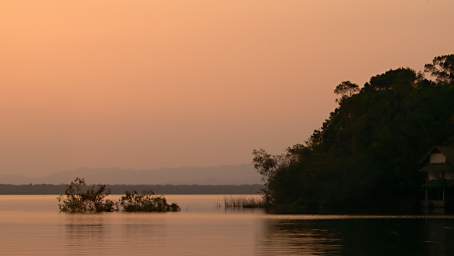 |
| Tree in Water, Bahia De Buena Vista |
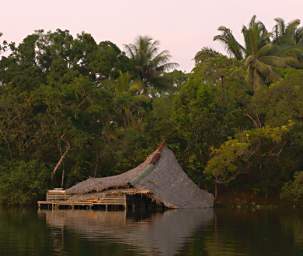 |
| Botrans' Palapa |
Another boat was tied to my mooring, so I found a clear spot and dropped the hook. When I talked to Jennifer I learned that the storm I had encountered while anchored near New Haven had been pretty violent on the Golfete as well. A lot of boats had dragged anchors. EOS, a large, heavy boat had dragged through her field of moorings. Some of the moorings had dragged, and two boats had been damaged; whether as a result of being hit by the big boat dragging through, or just by themselves dragging the moorings is unclear. A large motor yacht tied next to her house had banged itself up on the house, and one of the corner pilings supporting her deck was gone. Carabella, a ketch, had her mizzen-mast broken in half and her forestay broken.
 |
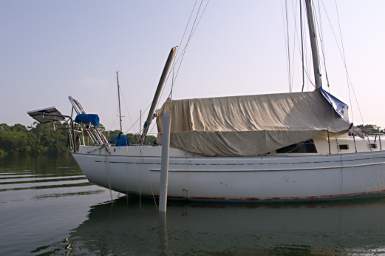 |
| Carabella, Missing her Forestay | Carabella, with Broken Mizzenmast |
 |
| EOS
You definitely don't won't a boat this big and heavy dragging your way in a storm. |
I spent the next morning helping Jennifer and Chico clean up Carabella. We removed the pieces of the mizzen mast, retrieved the roller furling and broken forestay, and added a temporary line from the masthead to the bow to replace the forestay. Jennifer said someone with an annemometer had reported sustained winds of 55 knots, with gusts over one minute at 65. Yowzer! That's a hurricane.
While climbing in and out of the cockpit at one point I managed to break the auto-pilot drive belt. I have two spares, but since I had some left-over dinghy repair glue that was going to go bad I patched it back together.
 |
| Broken Autopilot Belt |
The egrets seemed to like the tree which had blown down / into the bay; they seemed to congregate there every morning.
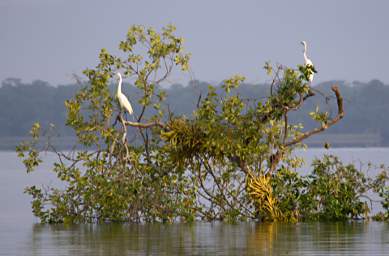 |
 |
| Egrets | Egrets on Downed Tree |
 |
| Egrets on Downed Tree |
Back on the river, it was hot and humid and still and I worried more about mosquitoes. But it was too warm to sleep comfortably in the cabin, at least during the first part of the night, so I rigged my mosquito netting in the cockpit.
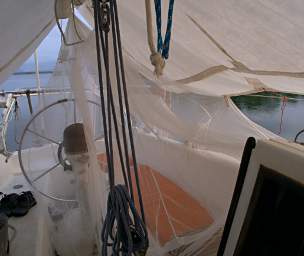 |
| Cockpit Mosquito Netting |
I was constantly reminded on this trip about the incredible abundance of life in the sea. That, despite the decimation that has occurred from over-fishing. I can only imagine what it must have been like five hundred years ago. Would that have been something to see! As it is, I was fortunate to see large schools of fish, and a great abundance and diversity on many reefs. Jennifer's bay is full of fish, although there are few of any size due to overharvest, and the restocking rate is probably below the minimum required to sustain the fishery. The local fishermen keep everything they catch, no matter how small. I see Mojara and some kind of catfish under the boat, schools of 1" minnows all around the boat feeding on something just under the surface, and at the dock in Independence there was a large school of catfish.
There is a wonderful array of birds in the bay. As well as the egrets, the swallows were always a delight, as were the cormorants. Parrots fly over every morning and evening, the Jacanas hop around on the lilypads in the creek outlet, Great Kiskadees keep nesting at the top of the masts, and hawks and vultures soar in the skies.
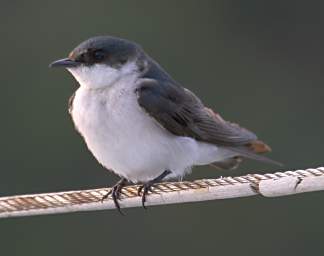 |
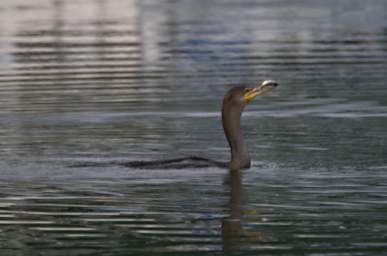 |
| Bird Xxx Swallow | Cormorant |
It used to be that the boats were the exclusive domain of the swallows, but the egrets have decided they are a good place to hang out. While I was working in the forepeak I heard some scratching and looked through the hatch to see an egret perched near the bow.
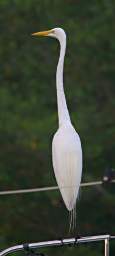 |
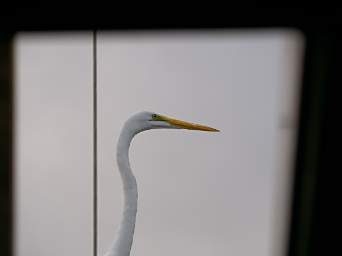 |
| Egret on Solmate | Egret Through Hatch |
I spent a day helping Jennifer and a neighbor, Gary Smith, and his guardian Jose using Malakii and Gary's big launch with a 200 hp Yamaha move the displaced moorings back where they belong, and doubling up some of them for better holding. Our biggest problem was lifting / breaking them out of the mud. In the process I bent Malakii's starboard anchor roller, then the windlass handle, and finally broke the 1" bronze shaft of the windlass. Ugh. The windlass is supposed to lift 550 lbs, and the moorings weighed about 400 lbs. in air, or about 230 lbs. under water. So in theory that shouldn't have been a problem, but I guess the mud factor put us over the top. The gypsy brake was frozen anyway, and I have not been able to take it apart or find parts, so I've been threatening to get a replacement anyway; I guess this is a push to get it done...
Jennifer and I went up to town a few days later and stopped by "Carlos the Welder" and left him the damaged anchor roller to fix and beef up. There are a number of craftsmen up in Fronteras who all must be related in some weird way, as they all have the same middle name -- Carlos the Welder, Dave the Plumber, Scott the Beekeeper, Manfred the Refrigeratorman, ...
We tried to buy some metal roofing ("lamina") to put a new roof on Jennifer's storage shed, as it had been damaged in the storm as well. But the two places we checked were out -- apparently a lot of other buildings were damaged and getting their roof's repaired or replaced also. A few days later I went up and found another place that had some, and they delivered it down to the dock and helped me load it into the launch.
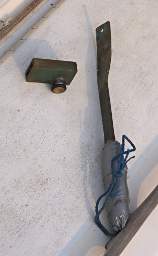 |
 |
| Windlass Shaft And Handle | Windlass Minus Shaft |
A local man came by every few days in his cayuco, selling baskets his wife made. Dona loves hand-made baskets so I bought her one.
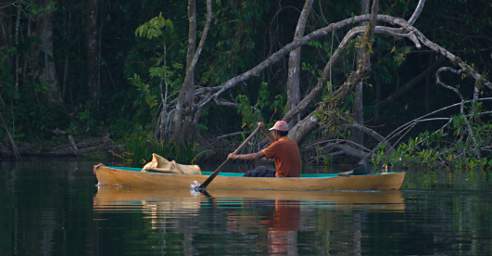 |
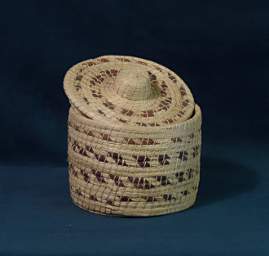 |
| Basket Man | Basket |
 |
| Basket Man |
I managed to get another anchor windlass I had received from Casey in a trade more or less working, although it still needs to be loosened up some more, so I didn't mount it. Before long it was time to head back. I buttoned up Malakii and took Casey and Jennifer out for a last supper.
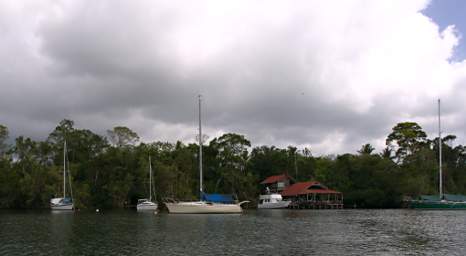 |
 |
| Malakii Buttoned Up | Malakii Buttoned Up |
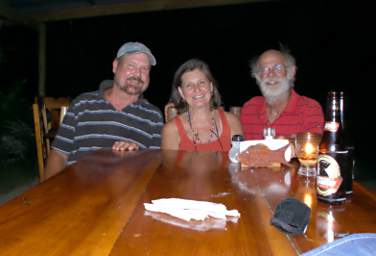 |
 |
| Casey, Jennifer and Gary | Casey and Jennifer |
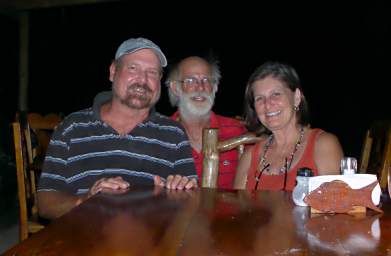 |
| Casey, Jennifer and Gary |
I went for a last swim in the bay that night, with wonderful streams of little sparkles of bioluminescence following me around. Then early the next morning Chico took me up to Fronteras to catch the bus back to Guatemala City.
 |
| Launch Chico |
For what it's worth, when I came back through Denver, United was behaving somewhat differently. They were announcing on the public address system for people who were about to miss their flight. I don't know if they have changed their policy about letting people on once the doors to the jetway are closed. But they obviously had a lot of complaints about their inconsiderate and callous treatment of their passengers.